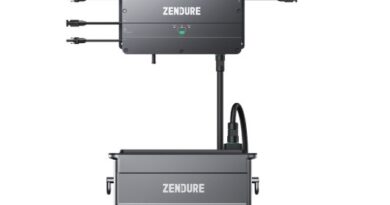Details on the Solarflow balcony power plant storage system
There’s news: In the last few days, a lot has happened with Zendure’s Solarflow balcony power plant storage solution. On the one hand, Zendure has created a product-related Facebook group especially for Solarflow. On the other hand, further product details have been announced, which I don’t want to withhold from you. In addition, the Zendure page has been revised and you can now also get an overview of the solution, technical data and detailed images there. Last but not least, there is a special offer where you can buy a voucher worth 200 euros for the purchase of the Solarflow solution for 50 euros. For those of you who just started to read about Solarflow with this article, here is a brief summary again. Solarflow is a modular balcony power plant storage solution. Solar flow is connected between the solar panels and the inverter, which feeds the electricity into the home network. On the Solarflow itself there is a junction to a battery storage system. This can be expanded up to a storage capacity of 3,840 Wh. So here are the latest infos: Input power: The solar input power of the Solarflow solution is 800 watts. Output power to the inverter: max. 1200 watts. This can be adjusted from 100 to 1,200 watts using the supplied app and is therefore suitable for a wide variety of inverters. Connection: The solar panels and the inverter are connected directly to the Solarflow solution via MC4 plugs, so that assembly should not pose a problem even for non technical people. In my opinion, anyone who has managed to put together their balcony power plant without a battery storage will also be able to plug in the solar flow without any problems. Battery power: maximum 3,840 Wh via modular design with up to 4 battery modules. The highlight here: The connection only requires one plug from the Solarflow to the battery module. The further modules are each set on top of the previous one. The battery warranty is 10 years. Weather resistance: The device has a metal design and is IP65 certified, as it is assumed that the Solarflow solution must withstand a wide range of outdoor weather conditions. App: The Solarflow solution comes with an app that shows how much energy is currently being produced and the storage status of the battery modules. The attentive reader will have noticed that I have not yet written anything about the price of the system. This has not been announced at this point in time. As soon as I know something about this, I will report accordingly. Other questions, which are already being discussed in the Solarflow group in addition to the price and which I am also asking myself, are whether more than 800 watts of solar power can be connected, since most current panels already deliver more than 400 watts. Will there be an interface to smart home solutions like the popular open source solution Home Assistant? So it remains exciting. I will keep you up-to-date. As ever I am eager to get your feedback so feel free to comment. best regards Chris
